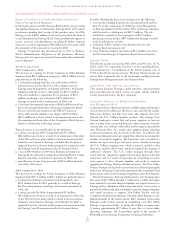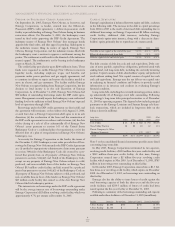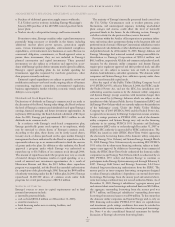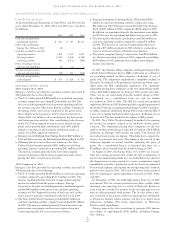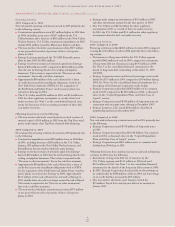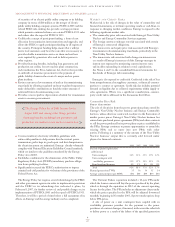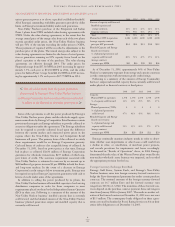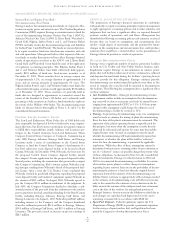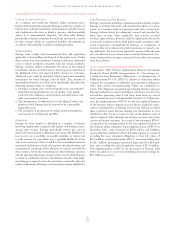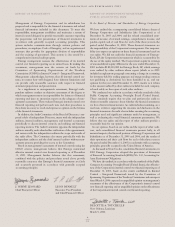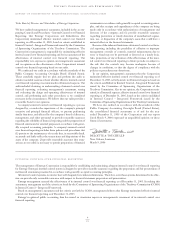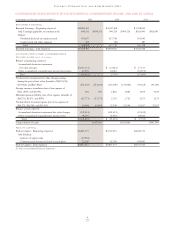Entergy 2005 Annual Report Download - page 51
Download and view the complete annual report
Please find page 51 of the 2005 Entergy annual report below. You can navigate through the pages in the report by either clicking on the pages listed below, or by using the keyword search tool below to find specific information within the annual report.
ENTERGY CORPORATION AND SUBSIDIARIES 2005
*
47
of securities of an electric public utility company or its holding
company in excess of $10 million or the merger of electric
public utility holding company systems. PUHCA 2005 and the
related FERC rule-making also provide a savings provision
which permits continued reliance on certain PUHCA 1935 rules
and orders after the repeal of PUHCA 1935.
■Codifies the concept of participant funding, a form of cost
allocation for transmission interconnections and upgrades, and
allows the FERC to apply participant funding in all regions of
the country. Participant funding helps ensure that a utility’s
native load customers only bear the costs that are necessary to
provide reliable transmission service to them and not bear
costs required by generators who seek to deliver power to
other regions.
■Provides financing benefits, including loan guarantees and
production tax credits, for new nuclear plant construction,
and reauthorizes the Price-Anderson Act, the law that provides
an umbrella of insurance protection for the payment of
public liability claims in the event of a major nuclear power
plant incident.
■Revises current tax law treatment of nuclear decommissioning
trust funds by allowing regulated and non-regulated taxpayers to
make deductible contributions to fund the entire amount of
estimated future decommissioning costs.
■Provides a more rapid tax depreciation schedule for transmission
assets to encourage investment.
■Creates mandatory electricity reliability guidelines with
enforceable penalties to help ensure that the nation’s power
transmission grid is kept in good repair and that disruptions in
the electricity system are minimized. Entergy already voluntarily
complies with National Electricity Reliability Council standards,
which are similar to the guidelines mandated by the Energy
Policy Act of 2005.
■Establishes conditions for the elimination of the Public Utility
Regulatory Policy Act’s (PURPA) mandatory purchase obliga-
tion from qualifying facilities.
■Significantly increased the FERC’s authorization to impose
criminal and civil penalties for violations of the provisions of the
Federal Power Act.
The Energy Policy Act requires several rulemakings by the FERC
and other government agencies in order to implement its provisions
and the FERC in its rulemakings has indicated it plans, by
February 8, 2007, for further review of, and possible changes to, its
implementation of PUHCA 2005 and the repeal of PUHCA 1935.
Therefore, it will be a period of time before a full assessment of its
effects on Entergy and the energy industry can be completed.
MARKET AND CREDIT RISKS
Market risk is the risk of changes in the value of commodity and
financial instruments, or in future operating results or cash flows, in
response to changing market conditions. Entergy is exposed to the
following significant market risks:
■The commodity price risk associated with Entergy’s Non-Utility
Nuclear and Energy Commodity Services segments.
■The foreign currency exchange rate risk associated with certain
of Entergy’s contractual obligations.
■The interest rate and equity price risk associated with Entergy’s
investments in decommissioning trust funds, particularly in the
Non-Utility Nuclear business.
■The interest rate risk associated with changes in interest rates
as a result of Entergy’s issuances of debt. Entergy manages its
interest rate exposure by monitoring current interest rates
and its debt outstanding in relation to total capitalization.
See Notes 4 and 5 to the consolidated financial statements for
the details of Entergy’s debt outstanding.
Entergy is also exposed to credit risk. Credit risk is the risk of loss
from nonperformance by suppliers, customers, or financial counter-
parties to a contract or agreement. Credit risk also includes potential
demand on liquidity due to collateral requirements within supply or
sales agreements. Where it is a significant consideration, counter-
party credit risk is addressed in the discussions that follow.
Commodity Price Risk
Power Generation
The sale of electricity from the power generation plants owned by
Entergy’s Non-Utility Nuclear business and Energy Commodity
Services, unless otherwise contracted, is subject to the fluctuation of
market power prices. Entergy’s Non-Utility Nuclear business has
entered into purchased power agreements (PPAs) and other contracts
to sell the power produced by its power plants at prices established in
the PPAs. Entergy continues to pursue opportunities to extend the
existing PPAs and to enter into new PPAs with other
parties. Following is a summary of the amount of the Non-Utility
Nuclear business’ output that is currently sold forward under
physical or financial contracts:
2006 2007 2008 2009 2010
Percent of planned generation
sold forward:
Unit-contingent 34% 32% 25% 19% 12%
Unit-contingent with
availability guarantees 53% 47% 32% 13% 5%
Firm liquidated damages 4% 2% 0% 0% 0%
Total 91% 81% 57% 32% 17%
Planned generation (TWh) 35 34 34 35 34
Average contracted price per MWh $41 $45 $49 $54 $45
The Vermont Yankee acquisition included a 10-year PPA under
which the former owners will buy the power produced by the plant,
which is through the expiration in 2012 of the current operating
license for the plant. The PPA includes an adjustment clause under
which the prices specified in the PPA will be adjusted downward
monthly, beginning in November 2005, if power market prices drop
below PPA prices.
A sale of power on a unit contingent basis coupled with an
availability guarantee provides for the payment to the power
purchaser of contract damages, if incurred, in the event the seller fails
to deliver power as a result of the failure of the specified generation
MANAGEMENT’S FINANCIAL DISCUSSION and ANALYSIS continued
The Energy Policy Act of 2005 became law in
August 2005 and, among other things, provides
financing benefits, including loan guarantees and
production tax credits for new nuclear construction.
<
>


